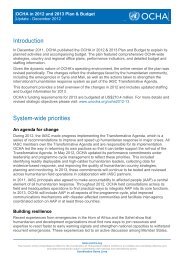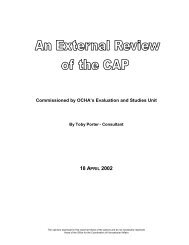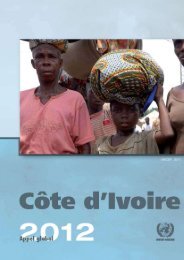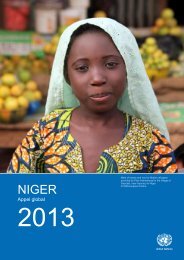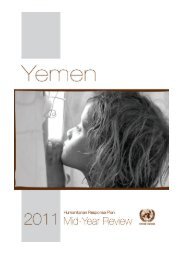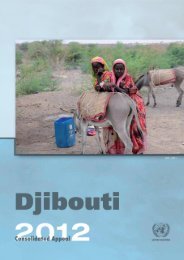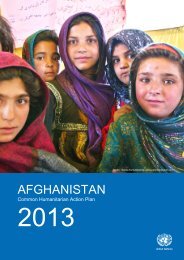SUDAN
Sudan: UN and Partners Work Plan 2012 - ReliefWeb
Sudan: UN and Partners Work Plan 2012 - ReliefWeb
- No tags were found...
You also want an ePaper? Increase the reach of your titles
YUMPU automatically turns print PDFs into web optimized ePapers that Google loves.
14[1] 2011 in review | changes in the context United Nations and PartnersSudan work plan 2012ments for farming and grazing. While the returns in 2011 wereassessed as voluntary, push and pull factors did exist, includingthe expectation that assistance would be provided andavailable upon arrival. However, returnees have experiencedchallenges since returning, including a lack of access to basicservices, livelihoods opportunities, and agricultural support,particularly in the form of access to arable farmland. Thesustainability of future returns will depend upon security andlivelihood opportunities, as well as on the provision of basicservices including the existence of community infrastructure,such as functioning health centres, schools and markets.Partners have also recorded around 1,000 overland returns fromLibya. The majority of these returnees were to North Darfur. Inaddition, the International Organization for Migration (IOM)supported the return of approximately 20,000 people by air toKhartoum, most of whom continued on to Darfur.Progress towards a comprehensive politicalsettlementWhile a comprehensive political settlement has remainedelusive, some political progress has been made between theGovernment and some elements of the armed oppositionmovements. In July, the culmination of the Doha negotiationsended with a signed agreement - the Doha Document forPeace in Darfur (DDPD) - between the Government and theLiberation and Justice Movement (LJM) - a grouping of smallarmed movements in Darfur. A Follow-up Committee on theImplementation of the DDPD has been established to overseeimplementation activities. However, neither the Governmentnor the larger armed opposition movements (the Justice andEquality Movement (JEM) and the Sudan Liberation Army/Abdul Wahid (SLA/AW) have made a concerted effort tore-engage in dialogue to widen the scope of the DDPD andresolve the conflict comprehensively.Meanwhile, UNAMID and the African Union High Level ImplementationPanel (AUHIP) continued to plan for the launch ofthe Darfur Political Process (DPP) during 2011. As a follow onfrom the Government of Sudan’s Darfur Peace and RecoveryStrategy (2010), the DPP is envisaged as a forum that willenable the people of Darfur to participate in organized consultationsaimed at broadening support for a comprehensivepeace agreement for the region. A Secretariat has been set upwithin UNAMID to facilitate implementation of the DPP andconsultations are expected to commence in early 2012.A challenging operating environment forhumanitarian actorsHumanitarian actors continue to face varying constraints onhumanitarian access in Darfur. In particular, areas under thecontrol of armed opposition movements, such as eastern andwest Jebel Marra, have remained largely inaccessible during2011 due to ongoing fighting or Governmental access restrictions.Humanitarian actors have faced specific restrictions onthe movement of humanitarian personnel and assets, includingmedical supplies, fuel, and other items necessary to sustainhumanitarian activities. For example, the Government enactedsecurity restrictions on movements outside of a 15 kilometre(km) radius of Nyala for a one-month period due to securityconcerns. Humanitarian access is also constrained by humanitarianactors’ internal security policies and impassable roadinfrastructure during the rainy season.In addition, there were some expulsions of humanitarian actorsand suspension of activities affecting humanitarian operations.For example, Médecins du Monde (MDM) was expelled fromSudan, and the head of the Fellowship for African Relief (FAR)was also expelled from the country. In several other cases, localdecisions to expel staff were eventually overturned followingthe intervention of the Humanitarian Coordinator and theMinistry of Humanitarian Affairs. For example, the internationalNGO, Catholic Relief Services (CRS), had to suspend itsactivities in West Darfur for a few months but the situation wasresolved and CRS was able to continue its activities.Several humanitarian organizations have either reducedor closed operations in particular locations in Darfur due toinsecurity. For example, the United Nations HumanitarianAir Service (UNHAS) ceased serving 15 deep field locations,including seven with existing humanitarian programmes, dueto the lack of adequate security arrangements on the groundthrough either UNAMID or the Sudanese police. At the sametime, the peacekeeping operation has also been affected bysecurity incidents in Darfur; 14 peacekeepers were killed in2011 during clashes with armed groups, several of which tookplace in or near IDP camps.Three Protocol AreasThere were outbreaks of fighting in each of the three Proto-fatality trends DarfurFatalities by year (Darfur)Documented fatalities per yearFatalities by month (Darfur)Documented fatalities, period Jan ‘08 to Oct ‘11Fatalities by statePeriod Nov ‘10 to Oct ‘11Fatalities by causePeriod Nov ‘10 to Oct ‘11171020088752009232120108272011*Jan-08Apr-08Jul-08Oct-08Jan-09Apr-09Jul-09Oct-09Jan-10Apr-10Jul-10Oct-10Jan-11Apr-11Jul-11Oct-116004503001500State # %North 362 32South 380 33West 244 22unsp. 146 13Total 1,132 100Cause # %Armed conflict 599 53Tribal / res. clash 102 9Crime / accidents 429 38Total 1,132 100Source: UNAMID Joint Mission Analysis Centre (JMAC), Monthly Threat Assessment Reports (2009-11); * 2011 data for Jan-Oct




